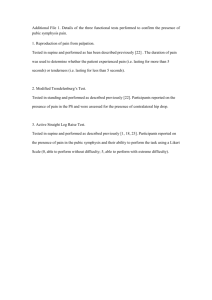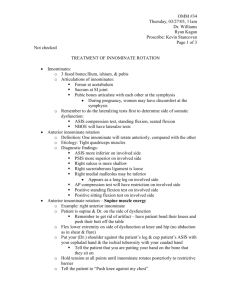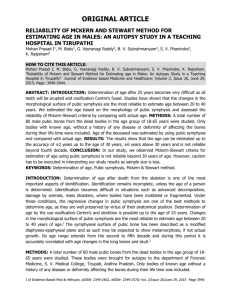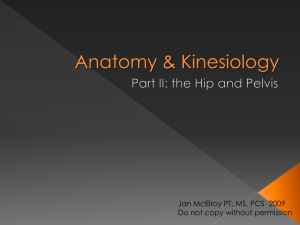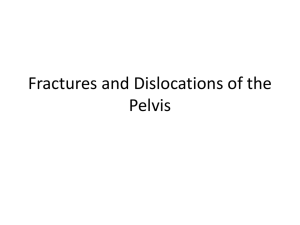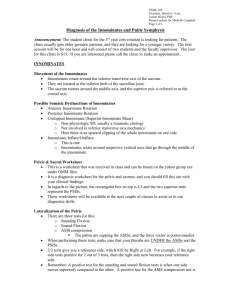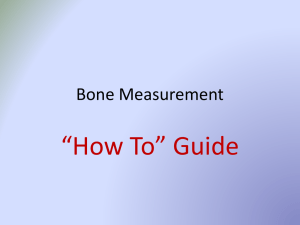OMM: Pubic Shear & Innominate Flare Treatment Techniques
advertisement
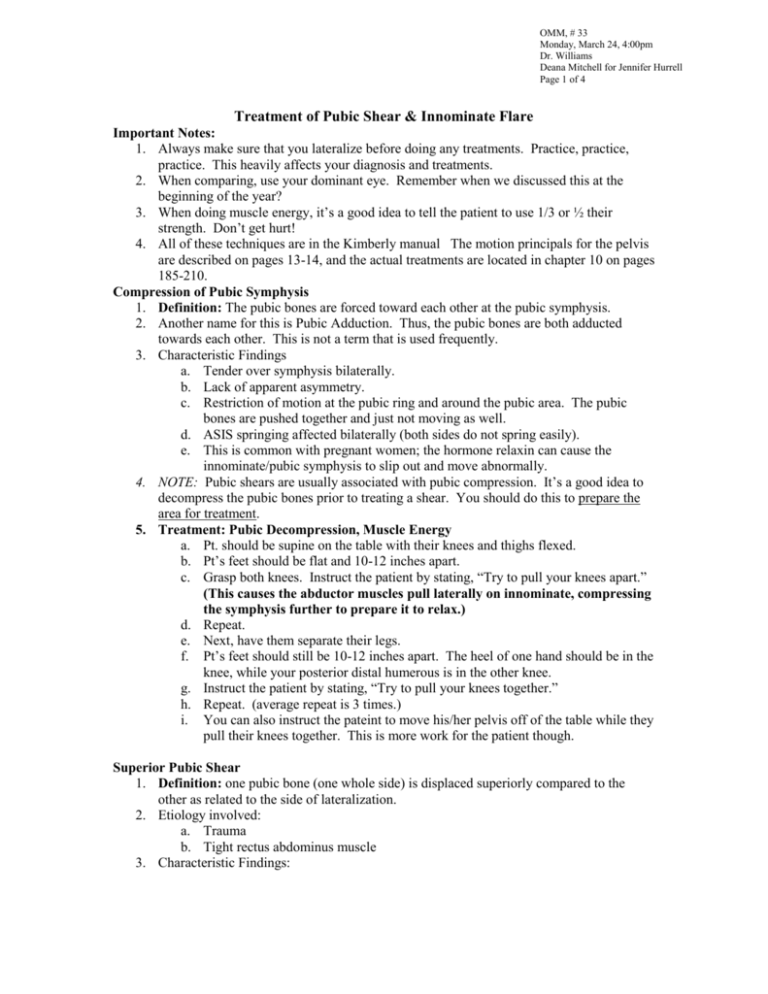
OMM, # 33 Monday, March 24, 4:00pm Dr. Williams Deana Mitchell for Jennifer Hurrell Page 1 of 4 Treatment of Pubic Shear & Innominate Flare Important Notes: 1. Always make sure that you lateralize before doing any treatments. Practice, practice, practice. This heavily affects your diagnosis and treatments. 2. When comparing, use your dominant eye. Remember when we discussed this at the beginning of the year? 3. When doing muscle energy, it’s a good idea to tell the patient to use 1/3 or ½ their strength. Don’t get hurt! 4. All of these techniques are in the Kimberly manual The motion principals for the pelvis are described on pages 13-14, and the actual treatments are located in chapter 10 on pages 185-210. Compression of Pubic Symphysis 1. Definition: The pubic bones are forced toward each other at the pubic symphysis. 2. Another name for this is Pubic Adduction. Thus, the pubic bones are both adducted towards each other. This is not a term that is used frequently. 3. Characteristic Findings a. Tender over symphysis bilaterally. b. Lack of apparent asymmetry. c. Restriction of motion at the pubic ring and around the pubic area. The pubic bones are pushed together and just not moving as well. d. ASIS springing affected bilaterally (both sides do not spring easily). e. This is common with pregnant women; the hormone relaxin can cause the innominate/pubic symphysis to slip out and move abnormally. 4. NOTE: Pubic shears are usually associated with pubic compression. It’s a good idea to decompress the pubic bones prior to treating a shear. You should do this to prepare the area for treatment. 5. Treatment: Pubic Decompression, Muscle Energy a. Pt. should be supine on the table with their knees and thighs flexed. b. Pt’s feet should be flat and 10-12 inches apart. c. Grasp both knees. Instruct the patient by stating, “Try to pull your knees apart.” (This causes the abductor muscles pull laterally on innominate, compressing the symphysis further to prepare it to relax.) d. Repeat. e. Next, have them separate their legs. f. Pt’s feet should still be 10-12 inches apart. The heel of one hand should be in the knee, while your posterior distal humerous is in the other knee. g. Instruct the patient by stating, “Try to pull your knees together.” h. Repeat. (average repeat is 3 times.) i. You can also instruct the pateint to move his/her pelvis off of the table while they pull their knees together. This is more work for the patient though. Superior Pubic Shear 1. Definition: one pubic bone (one whole side) is displaced superiorly compared to the other as related to the side of lateralization. 2. Etiology involved: a. Trauma b. Tight rectus abdominus muscle 3. Characteristic Findings: OMM, # 33 Monday, March 24, 4:00pm Dr. Williams Deana Mitchell for Jennifer Hurrell Page 2 of 4 a. First, do the lateralization tests to determine the involved side: ASIS compression, standing and seated flexion. The best of 2/3 will give you your side of lateralization for the patient. b. The pubic bone is superior on the involved side. c. There is generally a positive standing flexion test on the involved side. d. ASIS is superior. e. PSIS is inferior. f. ASIS compression is restricted on the involved side. g. It is tender to palpation over the pubic ramus. h. NOTE: If you have a superior pubic shear, you will have a posteriorly rotated innominate as well. However, you can have a posterior innominate without having a superior pubic shear. 4. Treatment: a. Pt. is supine with the DO on the dysfunctional side between the table and the leg. b. Stabilize the opposite ASIS with your hand. c. Have the patient move laterally until his/her ischial tuberosity is at the edge of the table. d. Abduct the knee to gap the symphysis. e. Extend the thigh. This rotates the innominate anteriorly and carries the symphysis inferiorly. f. Instruct the patient to, “Lift knee towards the ceiling.” g. Wait 3-5 seconds. h. Extend the thigh to the new barrier. When you do this, you are accomplishing two motions: Push the patient’s leg against the floor and extend it more with your leg. i. Repeat on the average of 3 times until best motion occurs. j. Recheck. Inferior Pubic Shear 1. Definition: one pubic bone is displaced more inferiorly than the other. 2. Etiology: a. trauma b. tight adductors 3. Characteristics: a. Pubic bone inferior on involved side. b. ASIS inferior on involved side. c. PSIS superior on involved side d. AP compression test restricted on involved side. e. Positive standing flexion test on involved side. f. Tenderness to palpation over pubic symphysis. g. When a patient says that their hip is hurting, this may be what is wrong, even though it is really not the correct medical definition of the hip. h. NOTE: If you have an inferior pubic shear, then you will also have an anteriorly rotated innominate. You can have an anterior innominate without a inferior pubic shear. 4. Treatment: a. Pt should be supine with the DO on the side of the dysfunction. b. Flex lower extremity at knee and hip and abduct thigh to gap pubic symphysis. OMM, # 33 Monday, March 24, 4:00pm Dr. Williams Deana Mitchell for Jennifer Hurrell Page 3 of 4 c. Place knee against chest, cup cephalad hand against ASIS, grasp (or cup) the ischial tuberosity with other hand. (This rotates innominate posteriorly to carry pubic symphysis superiorly.) d. Instruct the Pt to, “Push knee toward end of table against my chest.” e. Move innominate to new restrictive barrier. When you are doing this, flex and gap the patient more. You should be abducting their leg/knee more as well as pushing the knee superiorly and posteriorly into the patient’s body. As you flex, you are really taking the innominate and rotating it posteriorly (into the barrier), as well as gapping the pubic symphysis. f. Repeat until best motion. (approx. 3 times.) g. Recheck. Innominate Inflare 1. Definition: a condition where the innominate will rotate medially on a vertical axis. a. You usually don’t see a lot of these. b. Use the umbilicus as your reference point. This usually represents the midline. c. Use your thumb and finger to estimate the length from each ASIS to the umbilicus. You can use a measuring tape if you want. Dr. Williams suggested measuring your hand, or measuring your thumb to your index finger, so you will have a better estimate of your patient. 2. Physical Examination Findings: a. ASIS more medial on involved side. (lateralized side.) b. Use the umbilicus as reference point for anatomical midline. c. Positive standing flexion test on involved side. d. Ischial tuberosity farther from midline. e. Tender over SI or pubic symphysis. 3. Treatment: a. Pt. should be supine with the D.O. on the dysfunctional side. b. Hip & knee partially flexed, foot on table close to buttocks. c. Stabilize opposite ASIS. This is VERY important, especially in older patients. A good thing to say to your patient is, “Don’t worry, you’re not going to fall, you’ll hit me if you do and I’ll hold you up.” d. Move knee laterally abducting thigh to innominate’s restrictive barrier. e. Instruct the pateint to, “Move knee toward middle of table.” f. Wait 3-5 seconds & abduct thigh to new restrictive barrier. You are treating in an outflare mode when you do this. g. Repeat until best motion. (usually 3 times.) h. Recheck. Innominate Outflare 1. Definition: a condition where the innominate will rotate laterally on a vertical axis. 2. Physical Examination Findings: a. The side that lateralizes is the involved side. b. Use the umbilicus as a point of reference for the anatomical midline. c. ASIS more lateral on involved side. d. Ischial tuberosity nearer the midline. e. Tender to palpation over SI or pubic symphysis. OMM, # 33 Monday, March 24, 4:00pm Dr. Williams Deana Mitchell for Jennifer Hurrell Page 4 of 4 3. Treatment: a. Pt. should be supine while the D.O. is on the dysfunctional side. b. Pt’s knee & hip should be partially flexed. c. Grasp the patella with one hand and hook fingers of the other hand over medial margin of involved PSIS. d. Move knee medially adducting thigh to restrictive barrier. e. Instruct the Pt to, “Move knee outward.” f. Wait 3-5 seconds and adduct the thigh to new restrictive barrier by pushing the knee more medial. You are treating in an inflare mode when you do this. g. Repeat until best motion. (average of 3 times.) h. Recheck.
